Tag Archive: ALS
December 21, 2020
by Carole Zangari -

For people with complex communication needs to have access to stronger AAC services, we need more paraprofessional programs to provide mentored AAC experiences. In today’s post, we hear from Krista Davidson, a clinical associate professor in the Department of Communication Sciences and Disorders at The University of Iowa, on how she collaborated with a community organization to introduce student SLPs to AAC supports for people with ALS. Growing AAC Professionals: ALS Communication and Assistive Technology Learning Lab This December I thought I would share with you some more “gifts” of collaboration! The Department of Communication Sciences and Disorders at the University of Iowa uses a team approach to clinical education. Each student typically rotates through 6 specialty-based clinical teams, mine being the AAC Team. I am always looking for new opportunities for my team, especially experiences with client populations I may not have on my caseload. Fortuitously, I met Krista... [Read More...]
Filed under: Featured Posts, PrAACtical Thinking
Tagged With: ALS
July 23, 2020
by Carole Zangari -
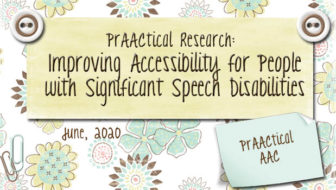
When clinicians, researchers, and individuals with AAC needs come together to work on a problem, good things can happen. In today’s post, SLP Katie Seaver tells us about her experiences with Project Euphonia. :::::::::::::::::::::::::::::::::::::::::::::::::::::::::::::::::::::::::::::::::::::::::::::::::::::::::::::::::::::::::::::::: My name is Katie Seaver and I have been an SLP for 16 years. For the past 10 year I have been an SLP and AAC Specialist at the Leonard Florence Center in Chelsea MA at their ALS Residence (see ALSRI.org for more information). The center is uniquely built to meet the extensive accessibility obstacles pALS experience. Each room is private with a fully automated environmental control with a program called PEAC. Once a resident has a device that allows them to access WiFi (e.g. an iPhone or even a Tobii Dynavox SGD) then they have access to their environment as well, from heating and TV, to doors and elevators. My passion for AAC has been... [Read More...]
Filed under: Featured Posts, PrAACtical Thinking
Tagged With: accessibility, ALS, research
May 21, 2018
by Carole Zangari -

People with declining speech abilities may wish to preserve some aspects of their speech through voice banking, message banking, and/or digital legacies. These are strategies used to digitally record speech by people with degenerative conditions, such as ALS/MND, for later use once their speech abilities decline. You can learn more about each strategy here. Voice Banking Voice banking is a strategy for creating a synthetic version of someone’s voice for later use on speech generating devices (SGD). It involves recording hundreds or thousands of sentences so that the computer can sample the person’s vocal qualities in different linguistic contexts and use that information to create a synthetic voice modeled after the person’s own speech. Options for Voice Banking include: Model Talker CereVoice Me VocalID My Own Voice Message Banking Message banking is a strategy for creating a pool of pre-recorded messages using a person’s natural speech while it is... [Read More...]
Filed under: Featured Posts, PrAACtical Thinking
Tagged With: ALS, digital legacy, message banking, voice banking
November 16, 2016
by Carole Zangari -
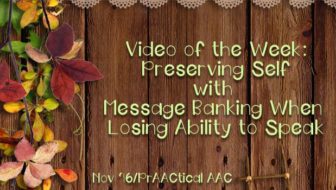
Have you been tuning into the USSAAC webinar series? If not, this is something to add to your calendar. Offered with the support of ISAAC, this series has had some wonderful speakers and topics. In today’s post, we share the most recent presentation with John Costello as the speaker. Enjoy! US friends, please consider supporting these efforts by becoming a USSAAC member. It is the only US organization to bring together people who use AAC, their families, and professionals from various disciplines. Direct Link to Video: https://www.youtube.com/watch?v=P2vmiH9tqUQ
Filed under: Video of the Week
Tagged With: ALS, message banking
February 23, 2014
by Carole Zangari -
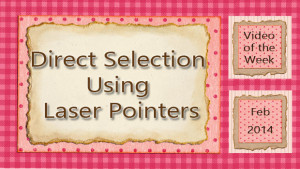
Looking for ways to support communicators with physical challenges? Laser pointers can be one way to provide access to communication boards and the alphabet. OT Margaret Cotts shows how it works in this interaction between a healthcare professional and a client with ALS. Although today’s featured video focuses on a client with ALS, this is an access tool that could work for individuals with other motor limitations as well. Direct Link to Video: http://www.youtube.com/watch?v=s0jlCq9QaM4
Filed under: Video of the Week
Tagged With: access, ALS, laser pointer, Margaret Cotts, motor impairment
May 15, 2013
by Carole Zangari -
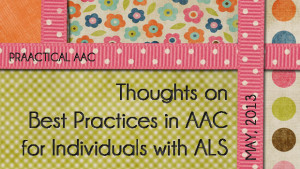
We’re always gratified by the collegiality of SLPs who work in AAC. In this video, Steven Bloch talks about the need for professionals to have real dialogue about clinical intervention and best practices. He shares his experience of organizing a group of professionals to develop best practice guidelines for working with people who have ALS/motor neuron disease. This brief presentation was recorded at a Therapy Ideas Live event at the Google campus in London this past March. You can access the material developed by Bloch and his colleagues here.
Filed under: PrAACtical Thinking
Tagged With: ALS, best practices, motor neurone disease
May 7, 2013
by Carole Zangari -
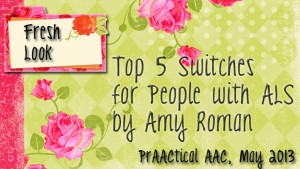
We continue our celebration of Better Hearing and Speech Month (#BHSM) with our Fresh Look series. In this post, we are delighted to share the insights of SLP Amy Roman, whose expertise in AAC supports for people with ALS is well-known. During the past 13 years, Amy has been a member of the multidisciplinary care team at San Francisco’s Forbes Norris ALS Research and Treatment Center. The AAC Program she developed at the Norris Center was awarded Program of the Year by the California Speech and Hearing Association in 2010. Through her private practice, she also provides AAC direct services and phone/skype consultations to individuals, caregivers and therapists. In addition, Amy is the Director of the Golden West ALS Association’s AAC Lending Library. She is also the author of AlphaCore© communication software available on DynaVox speech generating devices. Amy has presents workshops and at conferences on clinical and research topics in AAC.... [Read More...]
Filed under: PrAACtical Thinking
Tagged With: access, alerting system, ALS, Amy Roman, BHSM, call chime, Fresh Look, laser pointer, pALS, switch, switches
July 14, 2012
by Carole Zangari -
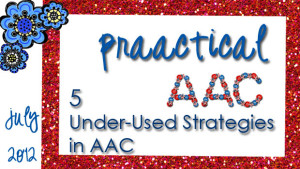
1. Partner-assisted scanning (PAS) offers great flexibility and spontaneity. Don’t want to take your SGD to the beach? A print-out of the screens and PAS is a great option. Missing key messages for the trip to the doctor’s office? A minute of brainstorming and the use of PAS may just save the day. No way for your client to access her device once she’s in bed? A communication board/book and PAS just might do the trick. – 2. Voice banking: For people are likely to lose their speech due to a degenerative disease, like ALS, the option of saving samples of their speech and having it digitized for future use seems to hold great appeal. We’d love to see more SLPs familiarize themselves with this strategy and the tools to implement it, so that this option is more widely used about individuals whose speech is deteriorating. – 3. Qualitative rating... [Read More...]
Filed under: PrAACtical Thinking
Tagged With: aided language input, ALS, ASD, intervention, partner assisted scanning, PAS, rating scales, resources, task analysis, teaching strategies, voice banking







